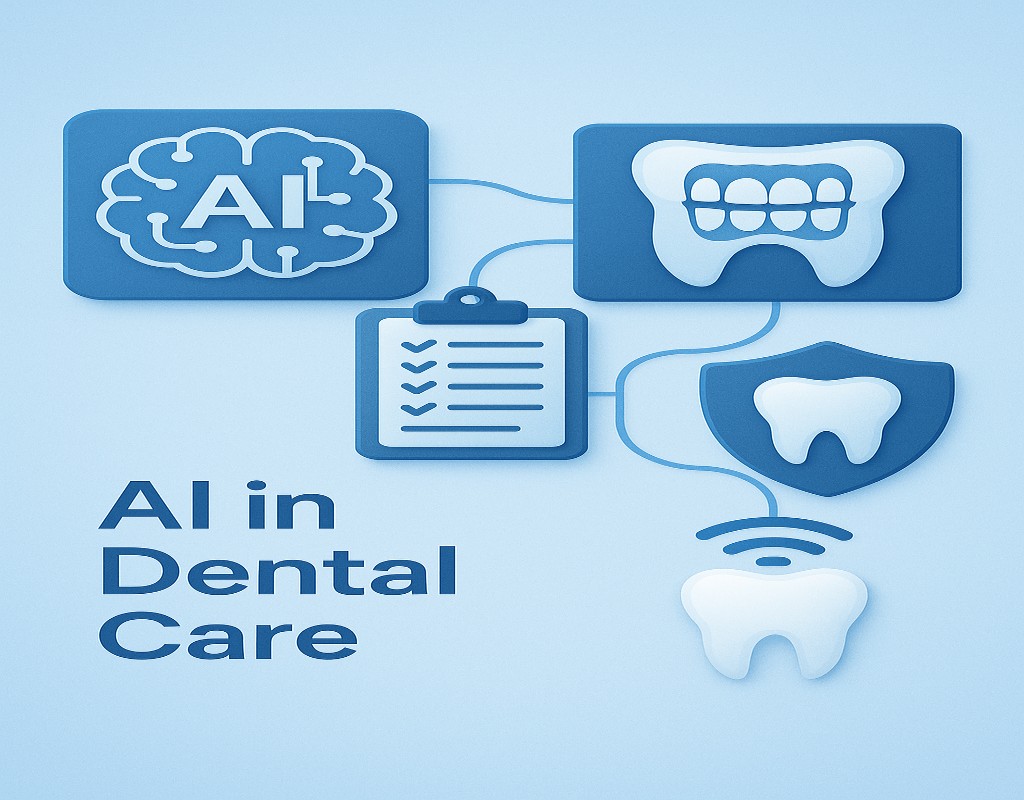

[et_pb_section admin_label="section"] [et_pb_row admin_label="row"] [et_pb_column type="4_4"][et_pb_text admin_label="Text"]
The application of Artificial Intelligence (AI) in contemporary healthcare has made a revolutionary change, and Dentistry is not different either. Right from the diagnosis phase to treatment planning and prevention, AI is becoming an integral part of the dental setup more and more.
With practitioners and patients constantly seeking more accuracy, speed, and tailored interactions, AI can fulfil these promises. From predicting oral disease early to improved clinical workflows, AI in Dentistry is revolutionizing the practice of dental care.
This article explains how AI in Dentistry enables more accurate, predictive, and patient-focused care. It also depicts how dental professionals are being augmented by AI-powered decision-support systems.
Dental Diagnosis: Fast, Precise, and Reproducible
Dental diagnosis in the past utilized a combination of manual evaluations, visual examination, tactile perception, and radiographs. They are decades old. They are still prone to human error, such as fatigue, subjective variation in judgment, and forgetfulness.
This is where the full potential of AI in dentistry begins to show. It offers speed, accuracy, and the ability to scan vast amounts of data with high precision.
AI models such as CNNs, having been trained on thousands of dental radiographs, can identify conditions such as early caries, gum disease, fractures, cysts, and even precancerous lesions very accurately in a snap.
For example, scanO Ecosystem is a system that assists in the interpretation of dental images taken on 3 angles based on AI. It offers real-time oral pathology detection and supplies dentists with annotated, clear visual outputs. These provide insights that minimize diagnostic uncertainty as well as aid in improved communication between the patient and the dentist.
Treatment Planning: Personalized, Predictive, and Efficient
Although correct diagnosis is important, treatment planning is where AI brings even greater personalized utility. AI systems can consider a patient's complete medical and dental background, radiographic information, intraoral scan, and case study information. With this as input, AI systems can recommend the most suitable and evidence-based treatment options.
AI in Dentistry provides individualized treatment plans specific to the condition and requirements of each patient. This also minimizes dependence on trial-and-error, which may at times prolong care or result in suboptimal outcomes.
scanO is also important in this stage. It delivers AI-driven reports that enable dentists to see lesion development or bone loss over time. Such information is useful when dealing with chronic cases or staged interventions.
This predictive understanding allows dentists to organize treatments more clearly, enhancing consistency and building the patient's confidence in the treatment process.
Chairside Support: Real-Time Intelligence and Clinical Confidence
In hectic clinical environments, real-time assistance can be a huge boon. AI in Dentistry is now providing live assistance and instant access to data, facilitating improved decision-making at the moment.
More sophisticated imaging equipment driven by artificial intelligence can now offer overlays on real-time images. Overlays assist in locating carious lesions, root canal courses, nerve canals, or margin lines during a procedure. Certain systems even come with voice commands so that clinicians can access patient information without interrupting sterility or stopping work.
scanO improves chairside efficiency through quick-to-interpret diagnostic images that may be simply reviewed during procedures. For instance, while performing a root canal, the dentist may refer instantly to a scanO report to validate the depth of a lesion or ascertain the location of a canal.
Such instruments ensure that every movement is accurate without disrupting the workflow. This, in turn, increases clinical confidence and patient safety.
Patient Education and Communication: Creating Trust and Understanding
Educating patients regarding their condition is a key aspect of contemporary dentistry. Many dental conditions, however, are hard to explain without the use of visual aids. This tends to confuse or make the patient anxious, particularly in the case of intricate treatment plans.
AI in Dentistry improves communication by visualization and interactivity. 3D treatment simulation, annotated radiographs, and simple visual stories allow patients to see what is happening inside their mouths and why they require treatment.
scanO produces patient-friendly reports in plain language and simple-to-follow graphics. Dentists can pinpoint exactly where the problem is, be it a patch of decay or a pocket of missing bone.
Such openness empowers patients to ask more questions and participate more in the decision-making process. It makes them more comfortable with the treatment plan and leads to greater compliance.
Preventive Dentistry: Active, Tailored, and Anticipatory
Dentistry is fast moving away from reactive to preventive care. AI is the prime driver for this change. AI-enabled devices of the present era can assist both clinicians and patients in recognizing risk factors in advance and preventing future issues.
These intelligent toothbrushes, wearables, and mobile apps now employ artificial intelligence to monitor brushing habits, detect sleep grinding, and identify initial enamel loss. The devices give personalized feedback to help individuals maximize oral hygiene techniques.
scanO allows preventive treatment by identifying early signs of pathology during a number of visits. scanO is able to track progressive bone loss, measure minor changes in lesion size, and warn of problems before they become symptomatic. This allows dentists a chance to intervene early with preventive measures like scaling, fluoride application, or lifestyle advice.
At a bigger scale, AI systems are able to gather information from large patient populations. This enables the identification of trends in oral health and can be utilized to plan public education programs or address specific community needs.
Conclusion: Bridging Dentistry with Intelligence
AI is transforming dental care at every point of contact. From diagnosis through to treatment planning, in-procedure assistance, patient education, and prevention, it is enhancing the way care is delivered and received.
AI is not meant to replace dentists. It is an efficient assistant, assisting them in making better decisions, streamlining workloads, and enhancing patient outcomes. It assists professionals in working more accurately and efficiently.
Software such as scanO, overjet, Pearl is evidence that AI isn't merely a promise of the future. It is an operational solution that is changing dentistry practices right now. Through the integration of clinical expertise with real-time data knowledge, applications such as scanO, overjet and Pearl are redefining what contemporary dentistry can do. AI unites precision, personalization, and empathy, providing both clinicians and patients with the best possible care.
[/et_pb_text][/et_pb_column] [/et_pb_row] [/et_pb_section]
scanO is an AI ecosystem transforming oral health for patients, dentists, corporates, and insurers worldwide

© 2025 Trismus Healthcare Technologies Pvt Ltd